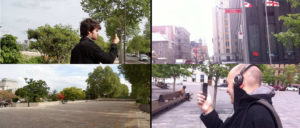
The figure of the walker, the wanderer or ‘travelling art’ have heavily fuelled contemporary art practices and thinking for the last ten years. Baudelaire’s wanderer, the situationist movement and, to a lesser extent, Land art (Hamish Fulton, Richard Long) have fed, in the background, the reflection on this new paradigm. ‘The artwork’ is experienced outside institutions, in urban areas and on a global scale. A ‘cinéplastique’is at work, which primarily focuses on gesture, performance and attitude, and no longer the object. The traces left behind and the photographic or videographic recordings testify to this ‘new’ mobility and allow one to build the narratives of those experiences. If the narrative must be reconstructed by the viewer, the anteriority of the gestures and the figure of the artist remain decisive.
In parallel, as early as 2001, artistic collectives coming from participatory theatre, such as the group Blast Theory or Rimini Protokoll, have engaged with the urban space in its real and fictional, physical and digital dimension, through the use of the mobile phone and its geolocation capabilities. This time, creation is not only collective but is also based on the experience of the participants. The experience of space is constructed collectively and integrates a spatial and narrative dimension. The technological and cultural environment, as well as social and political goals, drives the gaming scenarios that are deployed. The partitions between construction, reception and participation in the narratives that are implemented become porous without disappearing, however. The sensory and media means of these scenarios pass from one place to another, from sound to image, from informational to fictional text, or vice versa. They initiate the construction and experience of interactive and transmedia narratives.
The construction, reception and participation in narrativesthat serve as means for interaction between developers and participants now form three essential moments that must be understood, experimented and analysed.
Regarding the figure of the walker, one must question the ability of available documents and artworks to form narratives for ‘spectators’ and to engage their reception.
Regarding artistic devices in alternate realities, the triple device of construction, reception and participation may be the main focus of the studies analysed.
The issues of priority and dependence between these three moments will therefore become essential. If reception and participation form rather complementary schemes that of the construction of narratives will be considered as a prerequisite for reception and participation, without however forgetting the situations where these three moments are reciprocally constructed.
One obviously recognizes here the book that describes this new paradigm with great perspicacity and intelligence: Marcher, Créer by Thierry Davila, Editions du Regard, 2002.
Location Based Mobile Games (LBMG) or Hybrid Reality Games (HRG).
The definition of the narrative as sequence, plot and configuration proposed by Raphaël Baroni will help clarify an approach to narratives.
